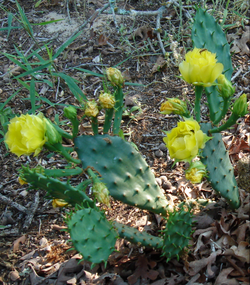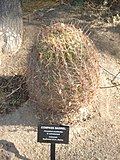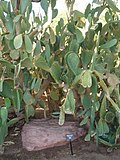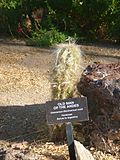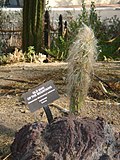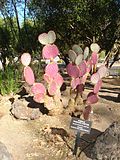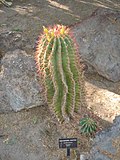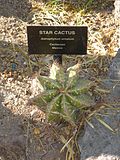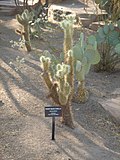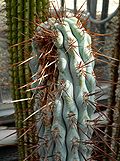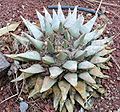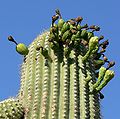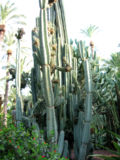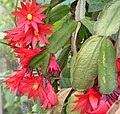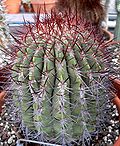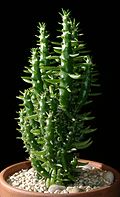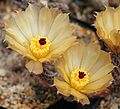Difference between revisions of "AY Honors/Cacti/Answer Key"
From Pathfinder Wiki
| (3 intermediate revisions by the same user not shown) | |||
| Line 1: | Line 1: | ||
| − | {{honor_header|1|1944|Nature | + | {{honor_header|1|1944|Nature|General Conference}} |
==1. Name the chief characteristics of a cactus.== | ==1. Name the chief characteristics of a cactus.== | ||
| Line 15: | Line 15: | ||
:Cacti are used for: | :Cacti are used for: | ||
| − | :1. Decorating | + | :1. '''Decorating''' - as [[W:Houseplants|houseplants]], in [[W:Xeriscape|dry gardens]], or, even as a [[W:Cactus_fence|fence]]. |
| − | :2. Edible Fruit Producing | + | :2. '''Edible Fruit Producing''' - such as [[W:Opuntia|Prickly Pear]], [[W:Hylocereus|Hylocereus]], [[W:Dragon_fruit|Dragon fruit]]. |
| − | :3. Psychoactive uses | + | :3. '''Psychoactive uses''' - the [[W:Peyote|Peyote]], ''Lophophora williamsii'', is a well-known [[W:Psychoactive|psychoactive agent]] used by Native Americans in southwestern United States. |
| + | |||
| + | :4. '''Host for bugs''' - the [[W:Opuntia|Opuntia]] is also used as a host for cochineal bugs for the [[W:Cochineal|Cochineal]] dye industry. | ||
==3. In what places are cacti the most plentiful? Why?== | ==3. In what places are cacti the most plentiful? Why?== | ||
| Line 41: | Line 43: | ||
Now go and identify more... | Now go and identify more... | ||
| + | <gallery> | ||
| + | Image:cactaceae-compass_barrel.jpg | ||
| + | Image:cactaceae-cows_tongue.jpg | ||
| + | Image:cactaceae-golden_barrel.jpg | ||
| + | Image:cactaceae-mission_cactus.jpg | ||
| + | Image:cactaceae-mojave_prickly_pear.jpg | ||
| + | Image:cactaceae-old_man_of_the_andes.jpg | ||
| + | Image:cactaceae-old_man_of_the_mountains.jpg | ||
| + | Image:cactaceae-purple_pancake_cactus.jpg | ||
| + | Image:cactaceae-rabbit_ears-with-rabbit.jpg | ||
| + | Image:cactaceae-red_barrel_cactus.jpg | ||
| + | Image:cactaceae-silver_cholla.jpg | ||
| + | Image:cactaceae-star_cactus.jpg | ||
| + | Image:cactaceae-teddy_bear_cholla.jpg | ||
| + | Image:cactaceae-south_american.jpg | ||
| + | </gallery> | ||
<br style="clear:both"> | <br style="clear:both"> | ||
| Line 47: | Line 65: | ||
There are different [[W:Taxonomy_of_the_Cactaceae|tribes of cacti]]: | There are different [[W:Taxonomy_of_the_Cactaceae|tribes of cacti]]: | ||
<gallery> | <gallery> | ||
| − | Image:Azureocereus imperator 3.jpg| | + | Image:Azureocereus imperator 3.jpg|B. hertlingiana (Tribe [[W:Browningia|Browningia]]) |
| − | Image:Ariocarpa retusus 1.jpg| | + | Image:Ariocarpa retusus 1.jpg|Ariocarpus retusus (Tribe [[W:Cacteae|Cacteae]]) |
| − | Image:Carnegiea gigantea top.jpg|Calymmantheae | + | Image:Carnegiea gigantea top.jpg|Calymmanthium (Tribe [[W:Calymmantheae|Calymmantheae]]) |
| − | Image:Cereus-peruvians1.jpg| | + | Image:Cereus-peruvians1.jpg|Cereus peruvianus (Tribe [[W:Cereeae|Cereeae]]) |
| − | Image:Hylocereus undatus.jpg| | + | Image:Hylocereus undatus.jpg|Hylocereus undatus (Tribe [[W:Hylocereeae|Hylocereeae]]) |
| − | Image:Parodia magnifica1.jpg| | + | Image:Parodia magnifica1.jpg|Parodia magnifica (Tribe [[W:Notocacteae|Notocacteae]]) |
| − | Image:Bergerocactus emoryi1MIBEA.jpg| | + | Image:Bergerocactus emoryi1MIBEA.jpg|Golden cereus (Tribe [[W:Pachycereeae|Pachycereeae]]) |
| − | Image:Schlumbergera gaertneri.JPG| | + | Image:Schlumbergera gaertneri.JPG|Schlumbergera gaertneri (Tribe [[W:Rhipsalideae|Rhipsalideae]]) |
| − | Image:Denmoza rhodacantha 1.jpg| | + | Image:Denmoza rhodacantha 1.jpg|D. rhodacantha (Tribe [[W:Trichocereeae|Trichocereeae]]) |
| − | Image:Austrocylindropuntia subulata0.jpg| | + | Image:Austrocylindropuntia subulata0.jpg|A. subulata (Tribe [[W:Austrocylindropuntieae|Austrocylindropuntieae]]) |
| − | Image:Opuntia brasiliensis2.jpg| | + | Image:Opuntia brasiliensis2.jpg|Cuija (Tribe [[W:Opuntieae|Opuntieae]]) |
| − | Image:Pterocactus kuntzei.jpg| | + | Image:Pterocactus kuntzei.jpg|Pterocactus tuberosus (Tribe [[W:Pterocacteae|Pterocacteae]]) |
| − | Image:Puna subterranea.jpg| | + | Image:Puna subterranea.jpg|Maihueniopsis subterranea (Tribe [[W:Tephrocacteae|Tephrocacteae]]) |
</gallery> | </gallery> | ||
==References== | ==References== | ||
[[Category:Adventist Youth Honors Answer Book|{{SUBPAGENAME}}]] | [[Category:Adventist Youth Honors Answer Book|{{SUBPAGENAME}}]] | ||
Revision as of 04:14, 3 October 2007
1. Name the chief characteristics of a cactus.
- Areoles - Flowers, branches, spines sprout from these- no other plant has this feature.
- Spines - Perhaps the most familiar feature of cacti, spines can vary greatly in appearance, shape, size, and color. Spines are not thorns.
- Flowers - Flowers are not unique to cacti, but cacti flowers are unique. Cacti flowers are typically quite spectacular and very complex. Unfortunately this field mark is only helpful, of course, if the plant happens to be blooming.
- Leaves - Most cacti do not have leaves, however, some do. Pay special attention to the presence or absence of leaves.
- Origin - All cacti are native to the America's and surrounding islands. With one exception - Rhipsalis baccifera. Although, world wide cultivation has made this less helpful for identification.
2. Name three uses of cacti.
- Cacti are used for:
- 1. Decorating - as houseplants, in dry gardens, or, even as a fence.
- 2. Edible Fruit Producing - such as Prickly Pear, Hylocereus, Dragon fruit.
- 3. Psychoactive uses - the Peyote, Lophophora williamsii, is a well-known psychoactive agent used by Native Americans in southwestern United States.
- 4. Host for bugs - the Opuntia is also used as a host for cochineal bugs for the Cochineal dye industry.
3. In what places are cacti the most plentiful? Why?
- Cacti are mostly found in extremely arid and hot environments.
- The majority of cacti are found in the North and South America as well as in the West Indies.
- Why? Cacti are adapted to arid and hot environments.
4. Know and identify from life or pictures 15 species of cacti.
Heh! This is your part. Enjoy!
I took photos of these two. Can you identify them?
Now go and identify more...
5. Photograph, observe or sketch at least 10 species of cacti and classify them or grow at least 3 different species of cacti.
There are different tribes of cacti:
B. hertlingiana (Tribe Browningia)
Ariocarpus retusus (Tribe Cacteae)
Calymmanthium (Tribe Calymmantheae)
Cereus peruvianus (Tribe Cereeae)
Hylocereus undatus (Tribe Hylocereeae)
Parodia magnifica (Tribe Notocacteae)
Golden cereus (Tribe Pachycereeae)
Schlumbergera gaertneri (Tribe Rhipsalideae)
D. rhodacantha (Tribe Trichocereeae)
A. subulata (Tribe Austrocylindropuntieae)
Cuija (Tribe Opuntieae)
Pterocactus tuberosus (Tribe Pterocacteae)
Maihueniopsis subterranea (Tribe Tephrocacteae)
